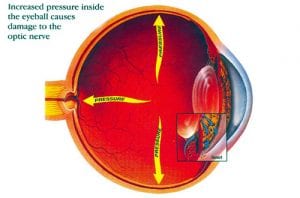 As if the ever-increasing number of Americans diagnosed with diabetes and hypertension didn’t have enough to worry about, a new study conducted at the University of Michigan Kellogg Eye Center has shown that individuals with diabetes and hypertension may be at an increased risk of developing open-angle glaucoma.
As if the ever-increasing number of Americans diagnosed with diabetes and hypertension didn’t have enough to worry about, a new study conducted at the University of Michigan Kellogg Eye Center has shown that individuals with diabetes and hypertension may be at an increased risk of developing open-angle glaucoma.
The research team was headed by Joshua D. Stein, M.D., M.S., a glaucoma specialist at Kellogg Eye Center. The team came to its conclusions by analyzing medical records of over two million people over the age of 40 who were registered with a managed care network and who visited an eye care specialist at least once from 2001 to 2007. They found that people with diabetes had a 35% increase in risk for developing open-angle glaucoma (OAG) while those with only hypertension saw a 17% increase in risk. Those who were diagnosed with both diabetes and hypertension had a whopping 48% increase for developing OAG—the most common form of glaucoma in the United States.
The researchers were specifically studying relationships and correlations between the elements of metabolic syndrome, a group of complications including diabetes, hypertension, heart disease, and hyperlipidemia, or increased triglyceride and cholesterol levels. Metabolic syndrome affects 20% of the population of the United States. The team studied each aspect of metabolic syndrome and its effect, if any, on the risk of OAG.
Although patients with diabetes and hypertension were at increased risk for developing OAG, those with hyperlipidemia alone were actually less likely to develop OAG by 5%. Further research is now being conducted to determine whether this is cause by the hyperlipidemia itself, by medication used to treat hyperlipidemia, or both. The researchers are hopeful that their findings may shed some light on new and unexpected treatments for glaucoma.
“Patients who have diabetes and hypertension are already known to be at elevated risk for eye conditions like diabetic retinopathy, a condition that harms the blood vessels in the retina,” said Stein. “This study and others suggest that, for these patients, an increased likelihood of glaucoma is also a concern.”
Glaucoma is the leading cause of blindness throughout the world. More than 2.2 million people have glaucoma in the United States and the numbers are only expected to rise as the population ages. The disease damages the optic nerves, gradually and permanently damaging the vision. The disease will progress to total vision loss and severe eye pain if left untreated.
Open-angle glaucoma isn’t always easily detected, as its symptoms typically don’t appear until it has progressed. OAG has acquired the nickname “the silent thief of sight” because the loss of vision isn’t immediate, instead progressing over a long period of time and patients often don’t seek treatment until the glaucoma has progressed significantly. The disease is irreversible, leading to permanent vision loss. However, if the disease is detected early, medication and surgery can slow or halt the progress of the disease.
Because of the difficulty in the detection of glaucoma, individuals with risk factors such as a family history of the disease, increased age, high intraocular pressure and being of a non-white race should be proactive in talking with their doctors about screening for glaucoma.
Closed-angle glaucoma is differentiated from open-angle glaucoma in that it usually occurs rapidly and causes rapid vision loss, but is more immediately painful than OAG and typically causes individuals to seek help before the disease progresses.
“This study reinforces the importance of regular eye examinations for patients at increased risk of glaucoma, including those with diabetes and hypertension,” said Dr. Stein.